Analysis, Design, and Simulation of Smart Grids - Project 300597
VerifiedAdded on 2023/03/31
|41
|7701
|400
Report
AI Summary
This report delves into the analysis, design, and simulation of smart grids, addressing the limitations of current communication infrastructures and the technological gaps in innovative practices. It explores analytical methodologies and simulation techniques to maximize efficiency, reliability, and resilience in smart grids, defining smart grids as electrical grids comprising smart appliances, meters, energy-efficient resources, and renewable energy. The research reviews existing literature to identify efficient analysis, simulation, and design approaches, highlighting the smart grid's reliability through state estimation, flexible network topology for bi-directional energy flows, and increased infrastructure efficiency via load adjustment. It also acknowledges the challenges related to cybersecurity and communication in smart grids, proposing effective strategies for analysis, simulation, and design to overcome these hurdles and improve grid performance, suggesting further research into optimal simulation tools for smart grid design. The document is available on Desklib, which offers a wide range of study resources, including past papers and solved assignments, for students.
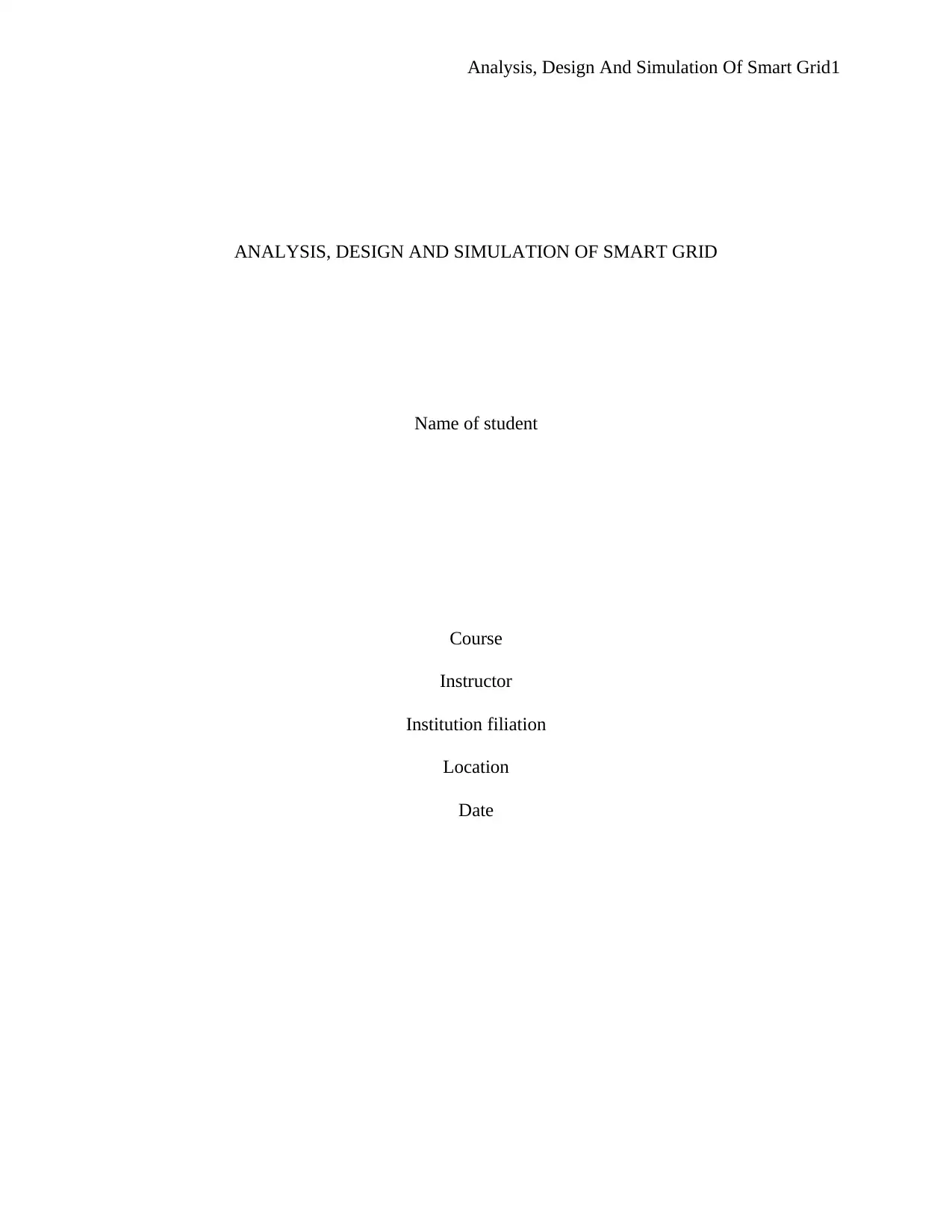
Analysis, Design And Simulation Of Smart Grid1
ANALYSIS, DESIGN AND SIMULATION OF SMART GRID
Name of student
Course
Instructor
Institution filiation
Location
Date
ANALYSIS, DESIGN AND SIMULATION OF SMART GRID
Name of student
Course
Instructor
Institution filiation
Location
Date
Paraphrase This Document
Need a fresh take? Get an instant paraphrase of this document with our AI Paraphraser
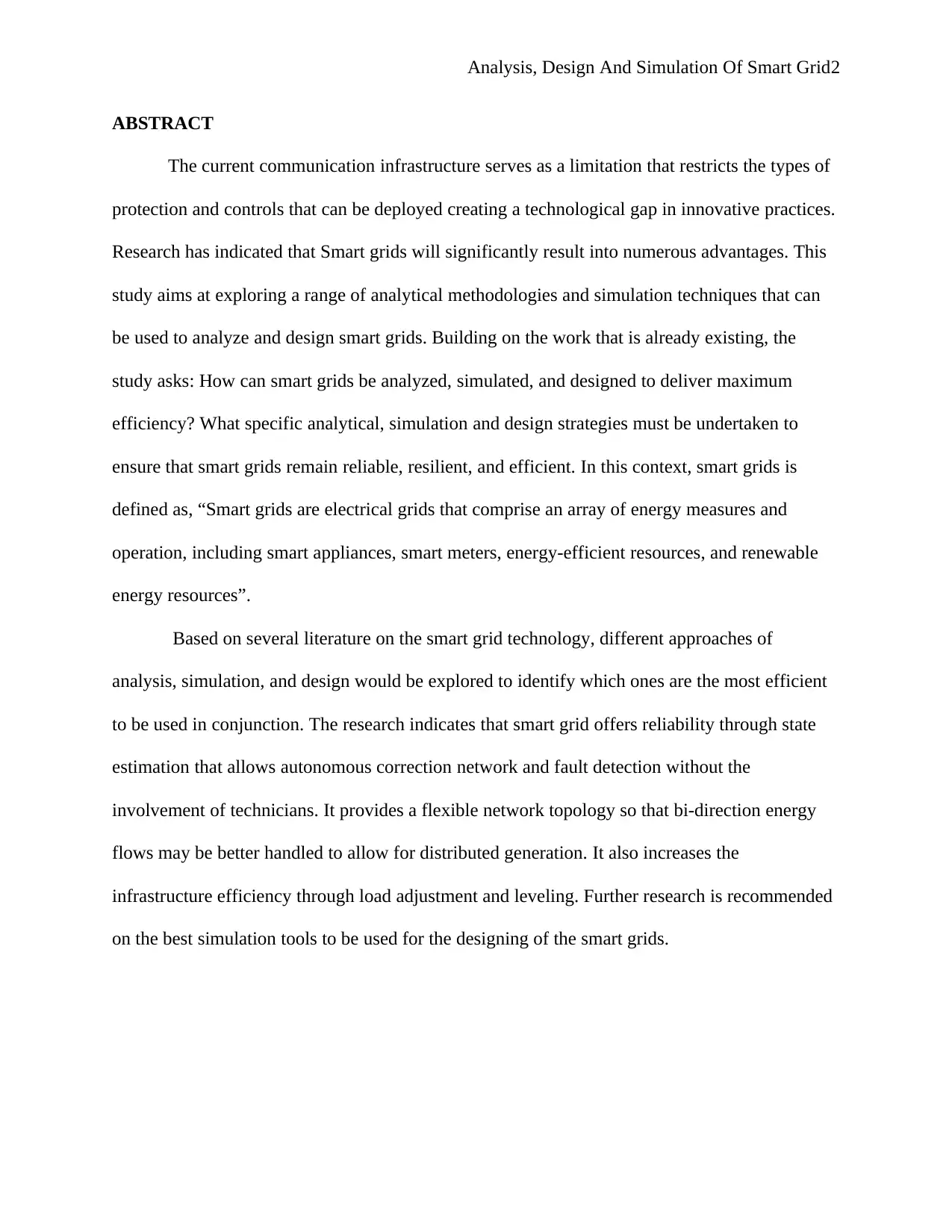
Analysis, Design And Simulation Of Smart Grid2
ABSTRACT
The current communication infrastructure serves as a limitation that restricts the types of
protection and controls that can be deployed creating a technological gap in innovative practices.
Research has indicated that Smart grids will significantly result into numerous advantages. This
study aims at exploring a range of analytical methodologies and simulation techniques that can
be used to analyze and design smart grids. Building on the work that is already existing, the
study asks: How can smart grids be analyzed, simulated, and designed to deliver maximum
efficiency? What specific analytical, simulation and design strategies must be undertaken to
ensure that smart grids remain reliable, resilient, and efficient. In this context, smart grids is
defined as, “Smart grids are electrical grids that comprise an array of energy measures and
operation, including smart appliances, smart meters, energy-efficient resources, and renewable
energy resources”.
Based on several literature on the smart grid technology, different approaches of
analysis, simulation, and design would be explored to identify which ones are the most efficient
to be used in conjunction. The research indicates that smart grid offers reliability through state
estimation that allows autonomous correction network and fault detection without the
involvement of technicians. It provides a flexible network topology so that bi-direction energy
flows may be better handled to allow for distributed generation. It also increases the
infrastructure efficiency through load adjustment and leveling. Further research is recommended
on the best simulation tools to be used for the designing of the smart grids.
ABSTRACT
The current communication infrastructure serves as a limitation that restricts the types of
protection and controls that can be deployed creating a technological gap in innovative practices.
Research has indicated that Smart grids will significantly result into numerous advantages. This
study aims at exploring a range of analytical methodologies and simulation techniques that can
be used to analyze and design smart grids. Building on the work that is already existing, the
study asks: How can smart grids be analyzed, simulated, and designed to deliver maximum
efficiency? What specific analytical, simulation and design strategies must be undertaken to
ensure that smart grids remain reliable, resilient, and efficient. In this context, smart grids is
defined as, “Smart grids are electrical grids that comprise an array of energy measures and
operation, including smart appliances, smart meters, energy-efficient resources, and renewable
energy resources”.
Based on several literature on the smart grid technology, different approaches of
analysis, simulation, and design would be explored to identify which ones are the most efficient
to be used in conjunction. The research indicates that smart grid offers reliability through state
estimation that allows autonomous correction network and fault detection without the
involvement of technicians. It provides a flexible network topology so that bi-direction energy
flows may be better handled to allow for distributed generation. It also increases the
infrastructure efficiency through load adjustment and leveling. Further research is recommended
on the best simulation tools to be used for the designing of the smart grids.

Analysis, Design And Simulation Of Smart Grid3
ACKNOWLEDGMENTS
I would like to begin by saying a word of thank you to my thesis advisor. His office was always
open whenever I had a problem with my thesis work. Consistently, he encouraged me to give my
best in the paper.
Also, I sincerely thanks the librarian who gave allowed me to do my research in the laboratory
and research facilities with less restriction. Finally, I must appreciate my parents for their
unending support and ceaseless reassurance through the process of researching and writing this
thesis. Lastly, I dedicate all this effort unto God for the His unending guidance, love and care as I
undertake my studies and particularly in this thesis work,
Author
ACKNOWLEDGMENTS
I would like to begin by saying a word of thank you to my thesis advisor. His office was always
open whenever I had a problem with my thesis work. Consistently, he encouraged me to give my
best in the paper.
Also, I sincerely thanks the librarian who gave allowed me to do my research in the laboratory
and research facilities with less restriction. Finally, I must appreciate my parents for their
unending support and ceaseless reassurance through the process of researching and writing this
thesis. Lastly, I dedicate all this effort unto God for the His unending guidance, love and care as I
undertake my studies and particularly in this thesis work,
Author
⊘ This is a preview!⊘
Do you want full access?
Subscribe today to unlock all pages.

Trusted by 1+ million students worldwide
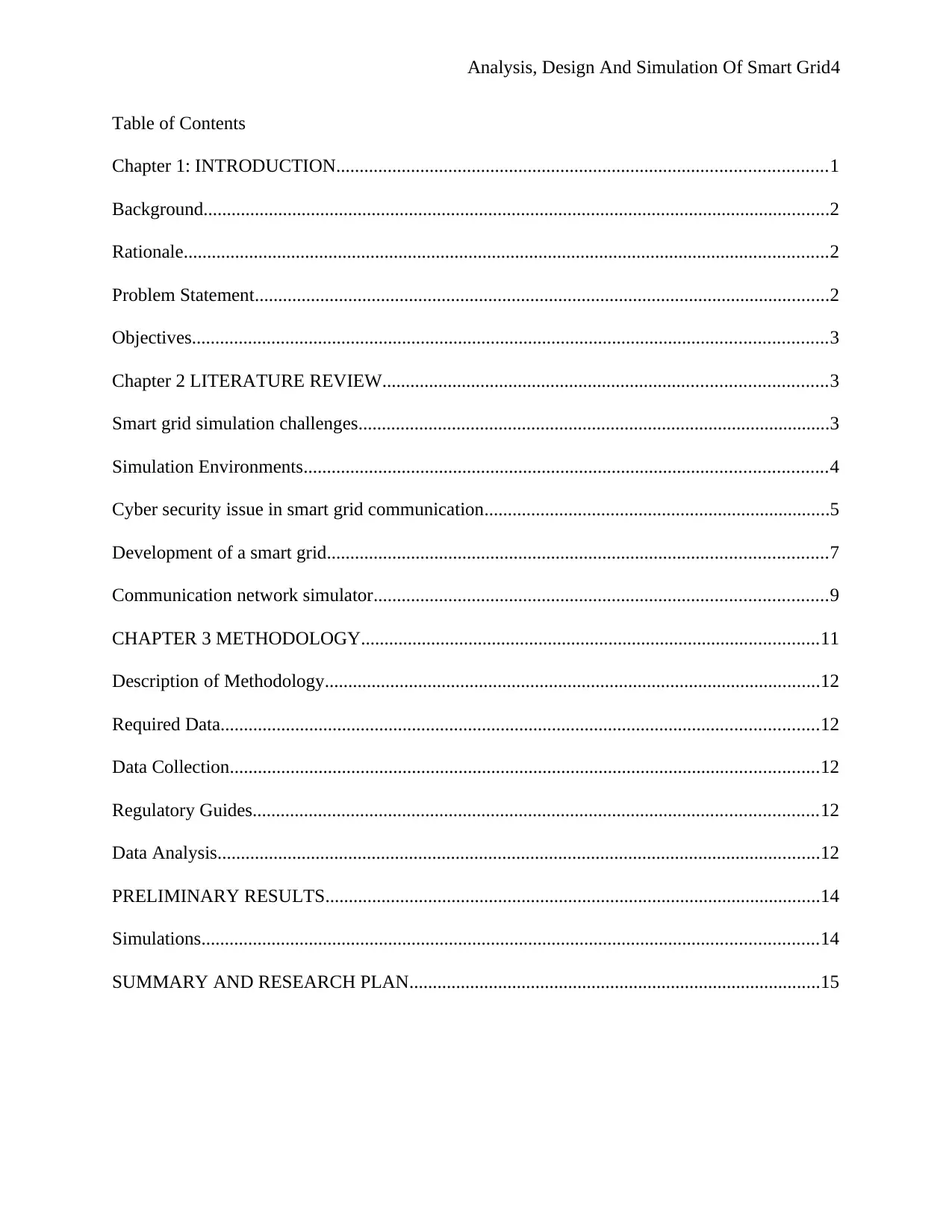
Analysis, Design And Simulation Of Smart Grid4
Table of Contents
Chapter 1: INTRODUCTION.........................................................................................................1
Background......................................................................................................................................2
Rationale..........................................................................................................................................2
Problem Statement...........................................................................................................................2
Objectives........................................................................................................................................3
Chapter 2 LITERATURE REVIEW...............................................................................................3
Smart grid simulation challenges.....................................................................................................3
Simulation Environments................................................................................................................4
Cyber security issue in smart grid communication..........................................................................5
Development of a smart grid...........................................................................................................7
Communication network simulator.................................................................................................9
CHAPTER 3 METHODOLOGY..................................................................................................11
Description of Methodology..........................................................................................................12
Required Data................................................................................................................................12
Data Collection..............................................................................................................................12
Regulatory Guides.........................................................................................................................12
Data Analysis.................................................................................................................................12
PRELIMINARY RESULTS..........................................................................................................14
Simulations....................................................................................................................................14
SUMMARY AND RESEARCH PLAN........................................................................................15
Table of Contents
Chapter 1: INTRODUCTION.........................................................................................................1
Background......................................................................................................................................2
Rationale..........................................................................................................................................2
Problem Statement...........................................................................................................................2
Objectives........................................................................................................................................3
Chapter 2 LITERATURE REVIEW...............................................................................................3
Smart grid simulation challenges.....................................................................................................3
Simulation Environments................................................................................................................4
Cyber security issue in smart grid communication..........................................................................5
Development of a smart grid...........................................................................................................7
Communication network simulator.................................................................................................9
CHAPTER 3 METHODOLOGY..................................................................................................11
Description of Methodology..........................................................................................................12
Required Data................................................................................................................................12
Data Collection..............................................................................................................................12
Regulatory Guides.........................................................................................................................12
Data Analysis.................................................................................................................................12
PRELIMINARY RESULTS..........................................................................................................14
Simulations....................................................................................................................................14
SUMMARY AND RESEARCH PLAN........................................................................................15
Paraphrase This Document
Need a fresh take? Get an instant paraphrase of this document with our AI Paraphraser

Analysis, Design And Simulation Of Smart Grid5
Table of figures
Figure 1 System operation over time (Source: Albasrawi et al., 2014) 7
Figure 3: Conceptual Models Of The Smart Grid 11
Figure 4: Picturesque View of the Smart Grid 11
Figure 5: Interface of DSDYN and DSOUT 14
Figure 6: OPNET Simulation 15
Figure 7: Event Handling 16
Figure 8 Steps for Methodology (Source: Self-created) 17
Figure 9: Power System and the Communication Network Simulators 19
Figure 10: Simulation Stands for Power Grid and Communication Network Respectively 20
Figure 11: Simulation Results 20
Figure 12: Flow of Co-Simulation and Event Handling 21
Tables
Table 1: Work Plan (Source: Self-created) 22
Table 2: Gantt chart (Source: Self-created) 23
Table of figures
Figure 1 System operation over time (Source: Albasrawi et al., 2014) 7
Figure 3: Conceptual Models Of The Smart Grid 11
Figure 4: Picturesque View of the Smart Grid 11
Figure 5: Interface of DSDYN and DSOUT 14
Figure 6: OPNET Simulation 15
Figure 7: Event Handling 16
Figure 8 Steps for Methodology (Source: Self-created) 17
Figure 9: Power System and the Communication Network Simulators 19
Figure 10: Simulation Stands for Power Grid and Communication Network Respectively 20
Figure 11: Simulation Results 20
Figure 12: Flow of Co-Simulation and Event Handling 21
Tables
Table 1: Work Plan (Source: Self-created) 22
Table 2: Gantt chart (Source: Self-created) 23
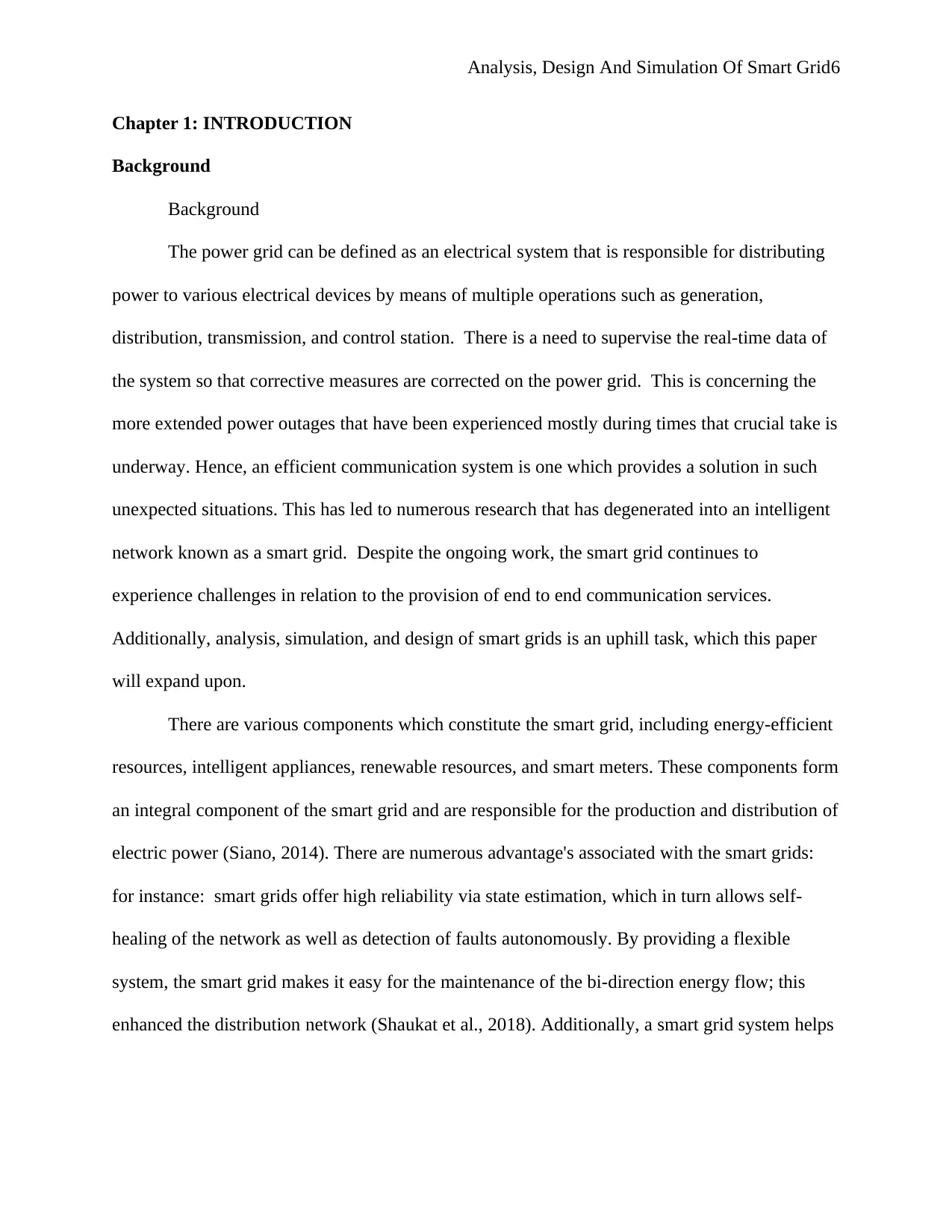
Analysis, Design And Simulation Of Smart Grid6
Chapter 1: INTRODUCTION
Background
Background
The power grid can be defined as an electrical system that is responsible for distributing
power to various electrical devices by means of multiple operations such as generation,
distribution, transmission, and control station. There is a need to supervise the real-time data of
the system so that corrective measures are corrected on the power grid. This is concerning the
more extended power outages that have been experienced mostly during times that crucial take is
underway. Hence, an efficient communication system is one which provides a solution in such
unexpected situations. This has led to numerous research that has degenerated into an intelligent
network known as a smart grid. Despite the ongoing work, the smart grid continues to
experience challenges in relation to the provision of end to end communication services.
Additionally, analysis, simulation, and design of smart grids is an uphill task, which this paper
will expand upon.
There are various components which constitute the smart grid, including energy-efficient
resources, intelligent appliances, renewable resources, and smart meters. These components form
an integral component of the smart grid and are responsible for the production and distribution of
electric power (Siano, 2014). There are numerous advantage's associated with the smart grids:
for instance: smart grids offer high reliability via state estimation, which in turn allows self-
healing of the network as well as detection of faults autonomously. By providing a flexible
system, the smart grid makes it easy for the maintenance of the bi-direction energy flow; this
enhanced the distribution network (Shaukat et al., 2018). Additionally, a smart grid system helps
Chapter 1: INTRODUCTION
Background
Background
The power grid can be defined as an electrical system that is responsible for distributing
power to various electrical devices by means of multiple operations such as generation,
distribution, transmission, and control station. There is a need to supervise the real-time data of
the system so that corrective measures are corrected on the power grid. This is concerning the
more extended power outages that have been experienced mostly during times that crucial take is
underway. Hence, an efficient communication system is one which provides a solution in such
unexpected situations. This has led to numerous research that has degenerated into an intelligent
network known as a smart grid. Despite the ongoing work, the smart grid continues to
experience challenges in relation to the provision of end to end communication services.
Additionally, analysis, simulation, and design of smart grids is an uphill task, which this paper
will expand upon.
There are various components which constitute the smart grid, including energy-efficient
resources, intelligent appliances, renewable resources, and smart meters. These components form
an integral component of the smart grid and are responsible for the production and distribution of
electric power (Siano, 2014). There are numerous advantage's associated with the smart grids:
for instance: smart grids offer high reliability via state estimation, which in turn allows self-
healing of the network as well as detection of faults autonomously. By providing a flexible
system, the smart grid makes it easy for the maintenance of the bi-direction energy flow; this
enhanced the distribution network (Shaukat et al., 2018). Additionally, a smart grid system helps
⊘ This is a preview!⊘
Do you want full access?
Subscribe today to unlock all pages.

Trusted by 1+ million students worldwide
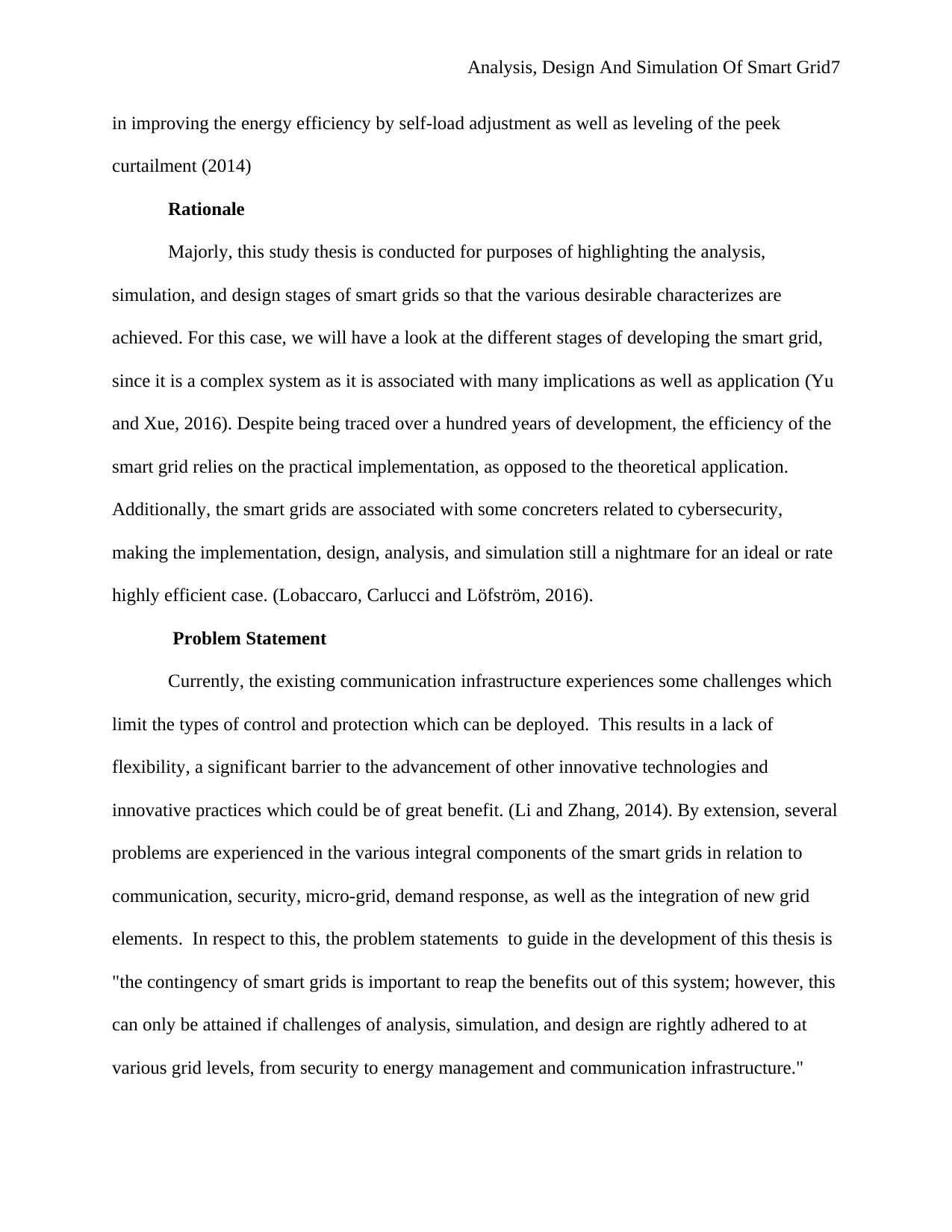
Analysis, Design And Simulation Of Smart Grid7
in improving the energy efficiency by self-load adjustment as well as leveling of the peek
curtailment (2014)
Rationale
Majorly, this study thesis is conducted for purposes of highlighting the analysis,
simulation, and design stages of smart grids so that the various desirable characterizes are
achieved. For this case, we will have a look at the different stages of developing the smart grid,
since it is a complex system as it is associated with many implications as well as application (Yu
and Xue, 2016). Despite being traced over a hundred years of development, the efficiency of the
smart grid relies on the practical implementation, as opposed to the theoretical application.
Additionally, the smart grids are associated with some concreters related to cybersecurity,
making the implementation, design, analysis, and simulation still a nightmare for an ideal or rate
highly efficient case. (Lobaccaro, Carlucci and Löfström, 2016).
Problem Statement
Currently, the existing communication infrastructure experiences some challenges which
limit the types of control and protection which can be deployed. This results in a lack of
flexibility, a significant barrier to the advancement of other innovative technologies and
innovative practices which could be of great benefit. (Li and Zhang, 2014). By extension, several
problems are experienced in the various integral components of the smart grids in relation to
communication, security, micro-grid, demand response, as well as the integration of new grid
elements. In respect to this, the problem statements to guide in the development of this thesis is
"the contingency of smart grids is important to reap the benefits out of this system; however, this
can only be attained if challenges of analysis, simulation, and design are rightly adhered to at
various grid levels, from security to energy management and communication infrastructure."
in improving the energy efficiency by self-load adjustment as well as leveling of the peek
curtailment (2014)
Rationale
Majorly, this study thesis is conducted for purposes of highlighting the analysis,
simulation, and design stages of smart grids so that the various desirable characterizes are
achieved. For this case, we will have a look at the different stages of developing the smart grid,
since it is a complex system as it is associated with many implications as well as application (Yu
and Xue, 2016). Despite being traced over a hundred years of development, the efficiency of the
smart grid relies on the practical implementation, as opposed to the theoretical application.
Additionally, the smart grids are associated with some concreters related to cybersecurity,
making the implementation, design, analysis, and simulation still a nightmare for an ideal or rate
highly efficient case. (Lobaccaro, Carlucci and Löfström, 2016).
Problem Statement
Currently, the existing communication infrastructure experiences some challenges which
limit the types of control and protection which can be deployed. This results in a lack of
flexibility, a significant barrier to the advancement of other innovative technologies and
innovative practices which could be of great benefit. (Li and Zhang, 2014). By extension, several
problems are experienced in the various integral components of the smart grids in relation to
communication, security, micro-grid, demand response, as well as the integration of new grid
elements. In respect to this, the problem statements to guide in the development of this thesis is
"the contingency of smart grids is important to reap the benefits out of this system; however, this
can only be attained if challenges of analysis, simulation, and design are rightly adhered to at
various grid levels, from security to energy management and communication infrastructure."
Paraphrase This Document
Need a fresh take? Get an instant paraphrase of this document with our AI Paraphraser
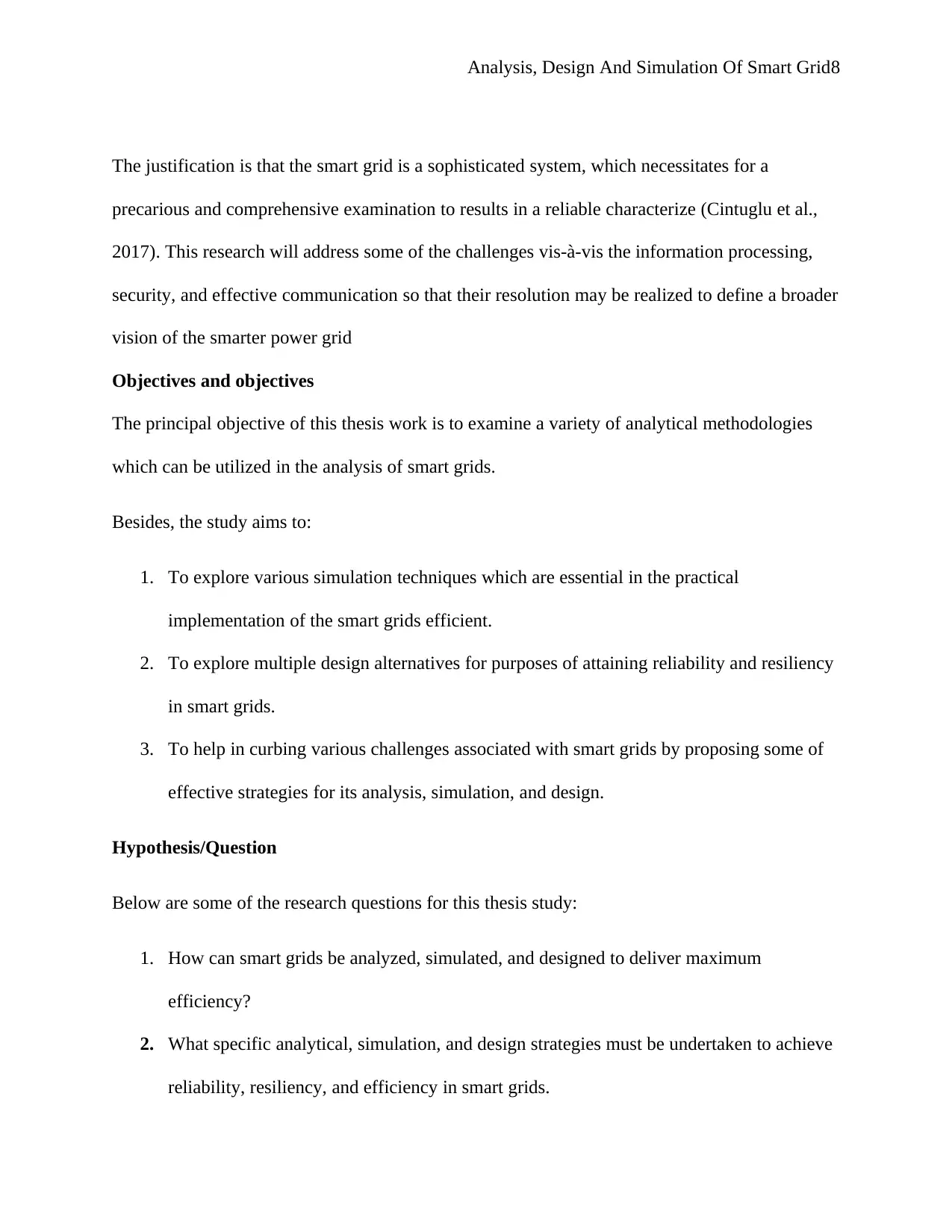
Analysis, Design And Simulation Of Smart Grid8
The justification is that the smart grid is a sophisticated system, which necessitates for a
precarious and comprehensive examination to results in a reliable characterize (Cintuglu et al.,
2017). This research will address some of the challenges vis-à-vis the information processing,
security, and effective communication so that their resolution may be realized to define a broader
vision of the smarter power grid
Objectives and objectives
The principal objective of this thesis work is to examine a variety of analytical methodologies
which can be utilized in the analysis of smart grids.
Besides, the study aims to:
1. To explore various simulation techniques which are essential in the practical
implementation of the smart grids efficient.
2. To explore multiple design alternatives for purposes of attaining reliability and resiliency
in smart grids.
3. To help in curbing various challenges associated with smart grids by proposing some of
effective strategies for its analysis, simulation, and design.
Hypothesis/Question
Below are some of the research questions for this thesis study:
1. How can smart grids be analyzed, simulated, and designed to deliver maximum
efficiency?
2. What specific analytical, simulation, and design strategies must be undertaken to achieve
reliability, resiliency, and efficiency in smart grids.
The justification is that the smart grid is a sophisticated system, which necessitates for a
precarious and comprehensive examination to results in a reliable characterize (Cintuglu et al.,
2017). This research will address some of the challenges vis-à-vis the information processing,
security, and effective communication so that their resolution may be realized to define a broader
vision of the smarter power grid
Objectives and objectives
The principal objective of this thesis work is to examine a variety of analytical methodologies
which can be utilized in the analysis of smart grids.
Besides, the study aims to:
1. To explore various simulation techniques which are essential in the practical
implementation of the smart grids efficient.
2. To explore multiple design alternatives for purposes of attaining reliability and resiliency
in smart grids.
3. To help in curbing various challenges associated with smart grids by proposing some of
effective strategies for its analysis, simulation, and design.
Hypothesis/Question
Below are some of the research questions for this thesis study:
1. How can smart grids be analyzed, simulated, and designed to deliver maximum
efficiency?
2. What specific analytical, simulation, and design strategies must be undertaken to achieve
reliability, resiliency, and efficiency in smart grids.
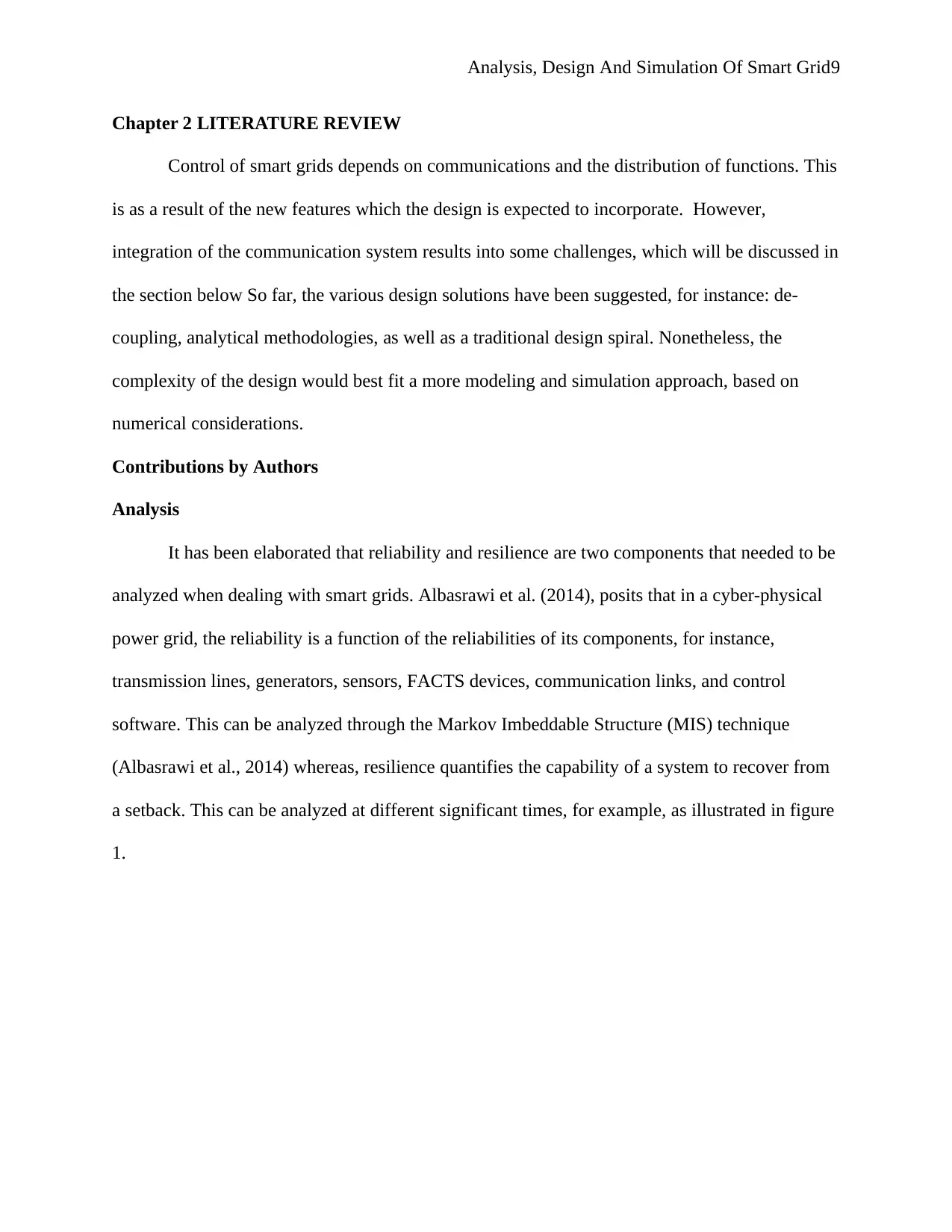
Analysis, Design And Simulation Of Smart Grid9
Chapter 2 LITERATURE REVIEW
Control of smart grids depends on communications and the distribution of functions. This
is as a result of the new features which the design is expected to incorporate. However,
integration of the communication system results into some challenges, which will be discussed in
the section below So far, the various design solutions have been suggested, for instance: de-
coupling, analytical methodologies, as well as a traditional design spiral. Nonetheless, the
complexity of the design would best fit a more modeling and simulation approach, based on
numerical considerations.
Contributions by Authors
Analysis
It has been elaborated that reliability and resilience are two components that needed to be
analyzed when dealing with smart grids. Albasrawi et al. (2014), posits that in a cyber-physical
power grid, the reliability is a function of the reliabilities of its components, for instance,
transmission lines, generators, sensors, FACTS devices, communication links, and control
software. This can be analyzed through the Markov Imbeddable Structure (MIS) technique
(Albasrawi et al., 2014) whereas, resilience quantifies the capability of a system to recover from
a setback. This can be analyzed at different significant times, for example, as illustrated in figure
1.
Chapter 2 LITERATURE REVIEW
Control of smart grids depends on communications and the distribution of functions. This
is as a result of the new features which the design is expected to incorporate. However,
integration of the communication system results into some challenges, which will be discussed in
the section below So far, the various design solutions have been suggested, for instance: de-
coupling, analytical methodologies, as well as a traditional design spiral. Nonetheless, the
complexity of the design would best fit a more modeling and simulation approach, based on
numerical considerations.
Contributions by Authors
Analysis
It has been elaborated that reliability and resilience are two components that needed to be
analyzed when dealing with smart grids. Albasrawi et al. (2014), posits that in a cyber-physical
power grid, the reliability is a function of the reliabilities of its components, for instance,
transmission lines, generators, sensors, FACTS devices, communication links, and control
software. This can be analyzed through the Markov Imbeddable Structure (MIS) technique
(Albasrawi et al., 2014) whereas, resilience quantifies the capability of a system to recover from
a setback. This can be analyzed at different significant times, for example, as illustrated in figure
1.
⊘ This is a preview!⊘
Do you want full access?
Subscribe today to unlock all pages.

Trusted by 1+ million students worldwide
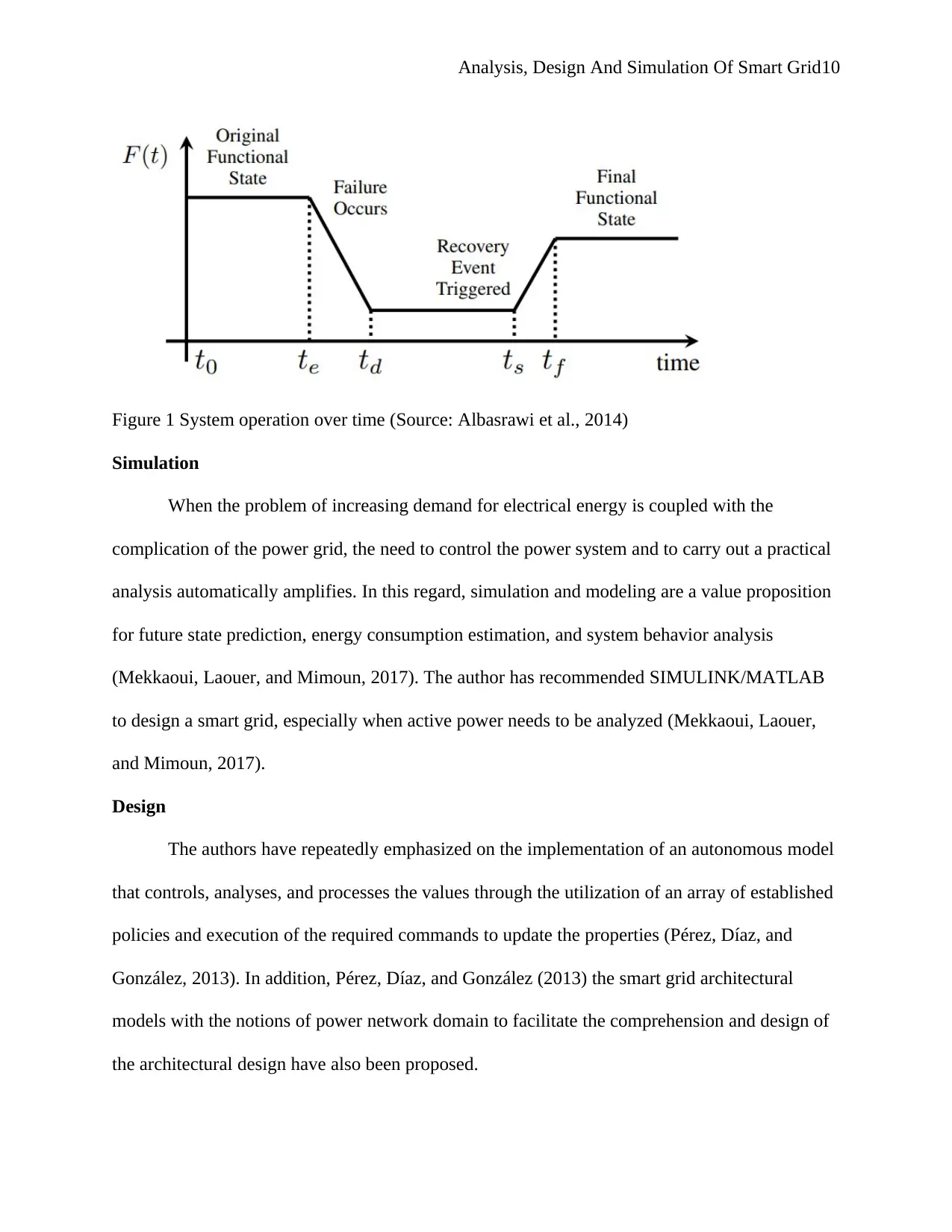
Analysis, Design And Simulation Of Smart Grid10
Figure 1 System operation over time (Source: Albasrawi et al., 2014)
Simulation
When the problem of increasing demand for electrical energy is coupled with the
complication of the power grid, the need to control the power system and to carry out a practical
analysis automatically amplifies. In this regard, simulation and modeling are a value proposition
for future state prediction, energy consumption estimation, and system behavior analysis
(Mekkaoui, Laouer, and Mimoun, 2017). The author has recommended SIMULINK/MATLAB
to design a smart grid, especially when active power needs to be analyzed (Mekkaoui, Laouer,
and Mimoun, 2017).
Design
The authors have repeatedly emphasized on the implementation of an autonomous model
that controls, analyses, and processes the values through the utilization of an array of established
policies and execution of the required commands to update the properties (Pérez, Díaz, and
González, 2013). In addition, Pérez, Díaz, and González (2013) the smart grid architectural
models with the notions of power network domain to facilitate the comprehension and design of
the architectural design have also been proposed.
Figure 1 System operation over time (Source: Albasrawi et al., 2014)
Simulation
When the problem of increasing demand for electrical energy is coupled with the
complication of the power grid, the need to control the power system and to carry out a practical
analysis automatically amplifies. In this regard, simulation and modeling are a value proposition
for future state prediction, energy consumption estimation, and system behavior analysis
(Mekkaoui, Laouer, and Mimoun, 2017). The author has recommended SIMULINK/MATLAB
to design a smart grid, especially when active power needs to be analyzed (Mekkaoui, Laouer,
and Mimoun, 2017).
Design
The authors have repeatedly emphasized on the implementation of an autonomous model
that controls, analyses, and processes the values through the utilization of an array of established
policies and execution of the required commands to update the properties (Pérez, Díaz, and
González, 2013). In addition, Pérez, Díaz, and González (2013) the smart grid architectural
models with the notions of power network domain to facilitate the comprehension and design of
the architectural design have also been proposed.
Paraphrase This Document
Need a fresh take? Get an instant paraphrase of this document with our AI Paraphraser
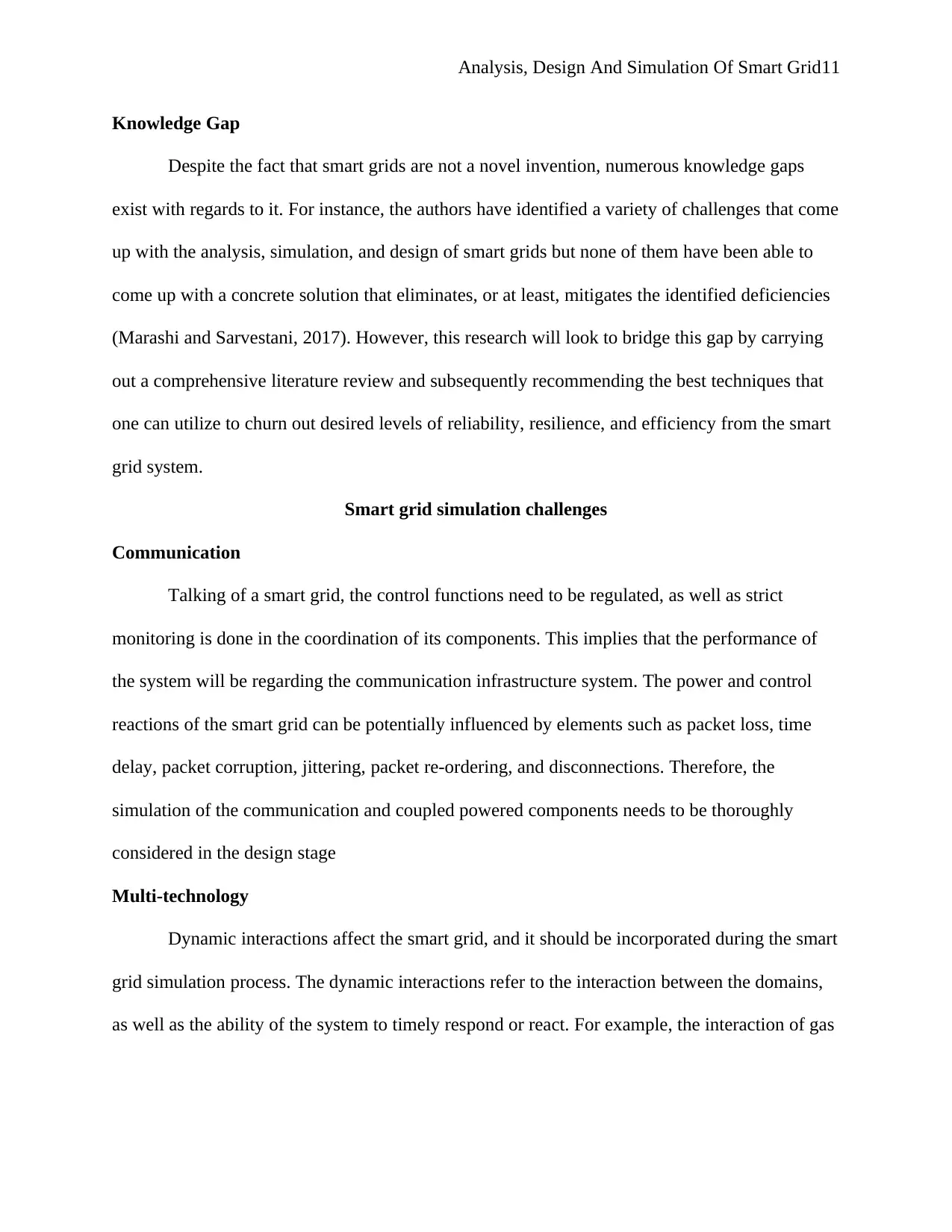
Analysis, Design And Simulation Of Smart Grid11
Knowledge Gap
Despite the fact that smart grids are not a novel invention, numerous knowledge gaps
exist with regards to it. For instance, the authors have identified a variety of challenges that come
up with the analysis, simulation, and design of smart grids but none of them have been able to
come up with a concrete solution that eliminates, or at least, mitigates the identified deficiencies
(Marashi and Sarvestani, 2017). However, this research will look to bridge this gap by carrying
out a comprehensive literature review and subsequently recommending the best techniques that
one can utilize to churn out desired levels of reliability, resilience, and efficiency from the smart
grid system.
Smart grid simulation challenges
Communication
Talking of a smart grid, the control functions need to be regulated, as well as strict
monitoring is done in the coordination of its components. This implies that the performance of
the system will be regarding the communication infrastructure system. The power and control
reactions of the smart grid can be potentially influenced by elements such as packet loss, time
delay, packet corruption, jittering, packet re-ordering, and disconnections. Therefore, the
simulation of the communication and coupled powered components needs to be thoroughly
considered in the design stage
Multi-technology
Dynamic interactions affect the smart grid, and it should be incorporated during the smart
grid simulation process. The dynamic interactions refer to the interaction between the domains,
as well as the ability of the system to timely respond or react. For example, the interaction of gas
Knowledge Gap
Despite the fact that smart grids are not a novel invention, numerous knowledge gaps
exist with regards to it. For instance, the authors have identified a variety of challenges that come
up with the analysis, simulation, and design of smart grids but none of them have been able to
come up with a concrete solution that eliminates, or at least, mitigates the identified deficiencies
(Marashi and Sarvestani, 2017). However, this research will look to bridge this gap by carrying
out a comprehensive literature review and subsequently recommending the best techniques that
one can utilize to churn out desired levels of reliability, resilience, and efficiency from the smart
grid system.
Smart grid simulation challenges
Communication
Talking of a smart grid, the control functions need to be regulated, as well as strict
monitoring is done in the coordination of its components. This implies that the performance of
the system will be regarding the communication infrastructure system. The power and control
reactions of the smart grid can be potentially influenced by elements such as packet loss, time
delay, packet corruption, jittering, packet re-ordering, and disconnections. Therefore, the
simulation of the communication and coupled powered components needs to be thoroughly
considered in the design stage
Multi-technology
Dynamic interactions affect the smart grid, and it should be incorporated during the smart
grid simulation process. The dynamic interactions refer to the interaction between the domains,
as well as the ability of the system to timely respond or react. For example, the interaction of gas
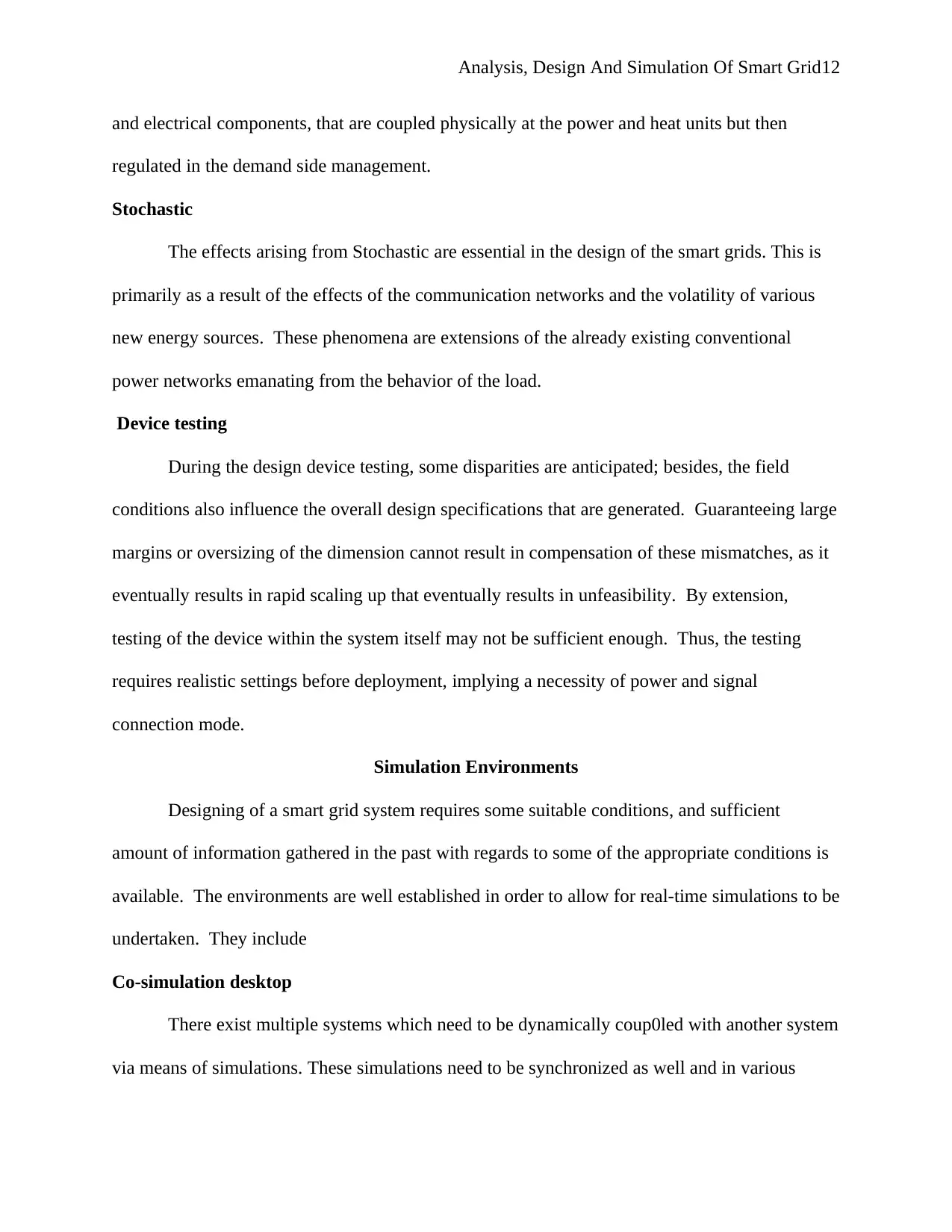
Analysis, Design And Simulation Of Smart Grid12
and electrical components, that are coupled physically at the power and heat units but then
regulated in the demand side management.
Stochastic
The effects arising from Stochastic are essential in the design of the smart grids. This is
primarily as a result of the effects of the communication networks and the volatility of various
new energy sources. These phenomena are extensions of the already existing conventional
power networks emanating from the behavior of the load.
Device testing
During the design device testing, some disparities are anticipated; besides, the field
conditions also influence the overall design specifications that are generated. Guaranteeing large
margins or oversizing of the dimension cannot result in compensation of these mismatches, as it
eventually results in rapid scaling up that eventually results in unfeasibility. By extension,
testing of the device within the system itself may not be sufficient enough. Thus, the testing
requires realistic settings before deployment, implying a necessity of power and signal
connection mode.
Simulation Environments
Designing of a smart grid system requires some suitable conditions, and sufficient
amount of information gathered in the past with regards to some of the appropriate conditions is
available. The environments are well established in order to allow for real-time simulations to be
undertaken. They include
Co-simulation desktop
There exist multiple systems which need to be dynamically coup0led with another system
via means of simulations. These simulations need to be synchronized as well and in various
and electrical components, that are coupled physically at the power and heat units but then
regulated in the demand side management.
Stochastic
The effects arising from Stochastic are essential in the design of the smart grids. This is
primarily as a result of the effects of the communication networks and the volatility of various
new energy sources. These phenomena are extensions of the already existing conventional
power networks emanating from the behavior of the load.
Device testing
During the design device testing, some disparities are anticipated; besides, the field
conditions also influence the overall design specifications that are generated. Guaranteeing large
margins or oversizing of the dimension cannot result in compensation of these mismatches, as it
eventually results in rapid scaling up that eventually results in unfeasibility. By extension,
testing of the device within the system itself may not be sufficient enough. Thus, the testing
requires realistic settings before deployment, implying a necessity of power and signal
connection mode.
Simulation Environments
Designing of a smart grid system requires some suitable conditions, and sufficient
amount of information gathered in the past with regards to some of the appropriate conditions is
available. The environments are well established in order to allow for real-time simulations to be
undertaken. They include
Co-simulation desktop
There exist multiple systems which need to be dynamically coup0led with another system
via means of simulations. These simulations need to be synchronized as well and in various
⊘ This is a preview!⊘
Do you want full access?
Subscribe today to unlock all pages.

Trusted by 1+ million students worldwide
1 out of 41
Related Documents
Your All-in-One AI-Powered Toolkit for Academic Success.
+13062052269
info@desklib.com
Available 24*7 on WhatsApp / Email
![[object Object]](/_next/static/media/star-bottom.7253800d.svg)
Unlock your academic potential
Copyright © 2020–2025 A2Z Services. All Rights Reserved. Developed and managed by ZUCOL.




